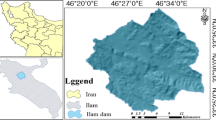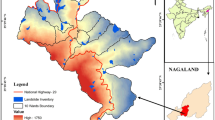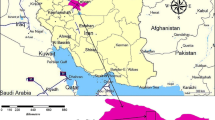Abstract
The purpose of this study is to assess the susceptibility of landslides around the area of Guizhou province, in south-west of China, using a geographical information system (GIS). The base map is prepared by visiting the field area and mapping individual landslide at a scale of 1:500,000 topographic maps. In the study, slope, lithology, landslide inventory, tectonic activity, drainage distribution and annual precipitation were taken as independent causal factors. Therefore, six causal factors maps are prepared by collecting information from various authorized sources and converting them in to GIS maps. The susceptibility assessment is based on the qualitative map combination model and trapezoidal fuzzy number weighting (TFNW) approach. Using a predicted map of probability, the study area was classified into four categories of landslide susceptibility: low, moderate, high and very high. In addition, the weighting procedure showed that the TFNW is an efficient method for landslide causal factors weighting.






Similar content being viewed by others
References
Akgün A, Bulut F (2007) GIS-based landslide susceptibility for Arsin-Yomra (Trabzon, North Turkey) region. Environ Geol 51:1377–1387
Aronoff S (1989) Geographic Information Systems: a management perspective. WDL Publications, Ottawa, p 294
Ayalew L, Yamagishi H (2005) The application of GIS-based logistic regression for landslide susceptibility mapping in the Kakuda-Yahiko mountains, Central Japan. Geomorphology 65:15–31
Ayalew L, Yamagishi H, Marui H, Kanno T (2005) Landslide in Sado Island of Japan: part II. GIS-based susceptibility mapping with comparison of results from two methods and verifications. Eng Geol 81:432–445
Baeza C, Corominas J (2001) Assessment of shallow landslide susceptibility by means of multivariate statistical techniques. Earth Surf Proc Land 26(12):1251–1263
Brabb EE (1984) Innovative approaches to landslide hazard mapping. In: Proceed. IV Int. Symp. Landslides, Toronto, pp 307–324
Carro M, De Amicis M, Luzi L, Marzorati S (2003) The application of predictive modeling techniques to landslides induced by earthquakes: the case study of the 26 September 1997 Umbria-Marche earthquake (Italy). Eng Geol 69(1–2):139–159
Çevik E, Topal T (2003) GIS-based landslide susceptibility mapping for a problematic segment of the natural gas pipeline, Hendek (Turkey). Environ Geol 44:949–962
Chou SY, Chang YH, Shen CY (2008) A fuzzy simple additive weighting system under group decision-making for facility location selection with objective-subjective attributes. Eur J Oper Res 189:132–145
Clerici A, Perego S, Tellini C, Vescovi P (2002) A procedure for landslide susceptibility zonation by the conditional analysis method. Geomorphology 48(4):349–364
Coppock J (1995) GIS and natural hazards: an overview from a GIS perspective. In: Carrara A, Guzzetti F (eds) Geographical information systems in assessing natural hazards. pp 21–34
Dai FC, Lee CF, Li J, Xu ZW (2001) Assessment of landslide susceptibility on the natural terrain of Lantau Island, Hong Kong. Environ Geol 40(3):381–391
Donati L, Turrini MC (2002) An objective method to rank the importance of the factors predisposing to landslides with the GIS Methodology: application to an area of the Apennines (Valnerina; Perugia, Italy). Eng Geol 63(3–4):277–289
Eastman R (1999) Multi-criteria evaluation and GIS. Chap. 35 In: Longley PA, Goodchild MF, Maguire DJ, Rhind DW (eds) Geographical information systems, Wiley, New York, pp 493–502
Galli M, Ardizzone F, Cardinali M, Guzzetti F, Reichenbach P (2008) Comparing landslide inventory maps. Geomorphology 94(3–4):268–289
Galang JS (2004) A comparison of GIS approaches to slope instability zonation in the central blue ridge mountains of virginia. Master, Virginia Polytechnic Institute and State University, Unite State
Guzzetti F, Cardinali M, Reichenbach P, Carrara A (2000) Comparing landslide maps: a case study in the upper Tiber River Basin, Central Italy. Environ Manage 25(3):247–363
Hansen A (1984) Landslide hazard analysis. In: Brunsden D, Prior DB (eds) Slope instability. Wiley, New York, pp 523–602
Jiang H, Eastman JR (2000) Application of fuzzy measures in multicriteria evaluation in GIS. Int J Geogr Inf Sci 14:173–184
Keufmann A, Gupta MM (1991) Introduction to fuzzy arithmetic: theory and application. Van Nostrand Reinhold, New York
Lee S, Choi U (2003) Development of GIS-based geological hazard information system and its application for landslide analysis in Korea. Geosci J 7(3):243–252
Lee S, Evangelista DG (2006) Earthquake-induced landslide-susceptibility mapping using an artificial neural network. Nat Hazard Earth Syst Sci 6:687–695
Lee S, Choi J, Woo I (2004a) The effect of spatial resolution on the accuracy of landslide susceptibility mapping: a case study in Boun, Korea. Geosci J 8(1):51–60
Lee S, Ryu JH, Won JS, Park HJ (2004b) Determination and application of the weights for landslide susceptibility mapping using an artificial neural network. Eng Geol 71(3–4):289–302
Ohlmacher GC, Davis JC (2003) Using multiple logistic regression and GIS technology to predict landslide hazard in northeast Kansa, USA. Eng Geol 69(3–4):331–343
Öztekin B, Topal T (2005) GIS-based detachment susceptibility analyses of a cut slope in limestone, Ankara, Turkey. Environ Geol 49:124–132
Parise M, Jibson RW (2000) A seismic landslide susceptibility rating of geologic units based on analysis of characteristics of landslides triggered by the 17 January, 1994 Northridge, California earthquake. Eng Geol 58(3–4):251–270
Pistocchi A, Luzi L, Napolitano P (2002) The use of predictive modeling techniques for optimal exploitation of spatial databases: a case study in landslide hazard mapping with expert system-like methods. Environ Geol 41(7):765–775
Refice A, Capolongo D (2002) Probabilistic modeling of uncertainties in earthquake-induced landslide hazard assessment. Comput Geosci 28(6):735–749
Saaty TL (1983) Axiomatic foundations of the analytic hierarchy process. Manage Sci 32:841–855
Saaty TL, Vargas GL (2001) Models, methods, concepts and applications of the analytic hierarchy process. Kluwer, Boston, pp 333
Saha AK, Gupta RP, Arora MK (2002) GIS-based landslide hazard zonation in the Bhagirathi (Ganga) valley, Himalayas. Int J Remote Sens 23(2):357–369
Sarkar S, Kanungo DP (2004) An integrated approach for landslide susceptibility mapping using remote sensing and GIS. Photogramm Eng Remote Sens 70(5):617–625
Şener B, Süzen ML, Doyuran V (2006) Landfill site selection by using geographic information systems. Environ Geol 49:376–388
Stevenson PC (1977) An empirical method for the evaluation of relative landslide risk. Bull Int Assoc Eng Geol 16:69–72
The Ministry of Land and Resource of China (2008) http://www.mlr.gov.cn/. Cited 2 Feb 2008
Varnes DJ (1978) Slope movement types and processes. Landslides: analysis and control. Transportation research board special report. Natl Acad Sci 176:11–33
Varnes DJ (1984) Landslide hazard zonation: a review of principles and practice. UNESCO, Paris, 63 pp
Van Westen CJ (1994) GIS in landslide hazard zonation: a review, with examples from the Colombian Andes. In: Heywood DI (ed) Mountain environments and geographic information systems, vol 1. Taylor and Francis, London, pp 135–165
Van Westen CJ (1997) Statistical landslide analysis. ILWIS 2.1. for windows application quide. ITC Publication, Enschede, pp 73–84
Zhou CH, Lee CF, Li J, Xu ZW (2002) On the spatial relationship between landslides and causative factors on Lantau Island, Hong Kong. Geomorphology 43(3–4):197–207
Zhou G, Esaki T, Mitani Y, Xie M, Mori J (2003) Spatial probabilistic modeling of slope failure using an integrated GIS Monte Carlo simulation approach. Eng Geol 68(3–4):373–386
Acknowledgments
The research work was supported by West Project of Ministry Communication, China. The authors appreciate Dr. Hesham Rakha, the professor of Virginia Polytechnic Institute and State University, for providing good research condition. Also, we are grateful to anonymous referees for their useful comments and careful manuscript reviewing.
Author information
Authors and Affiliations
Corresponding author
Rights and permissions
About this article
Cite this article
Wang, W.D., Xie, C.M. & Du, X.G. Landslides susceptibility mapping based on geographical information system, GuiZhou, south-west China. Environ Geol 58, 33–43 (2009). https://doi.org/10.1007/s00254-008-1488-5
Received:
Accepted:
Published:
Issue Date:
DOI: https://doi.org/10.1007/s00254-008-1488-5




